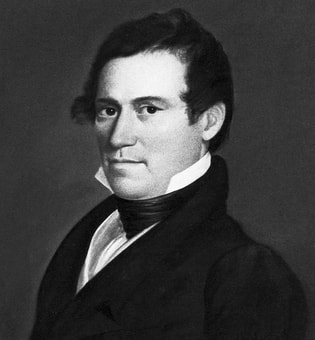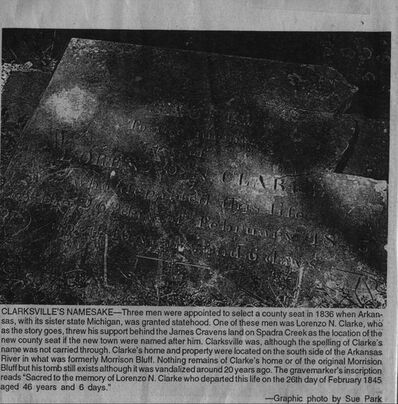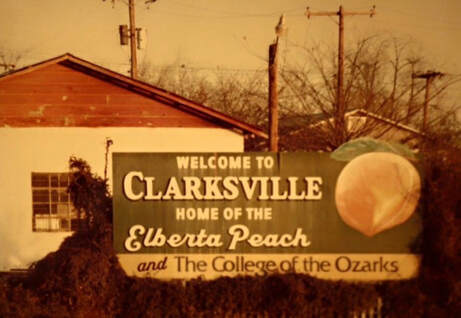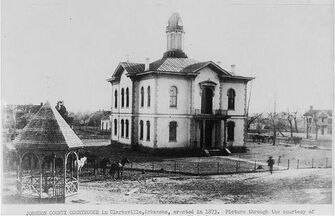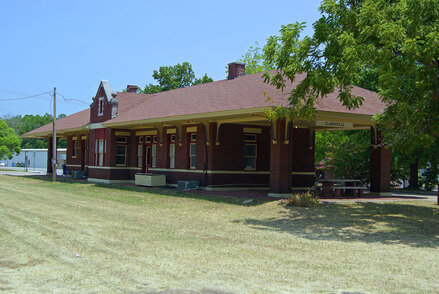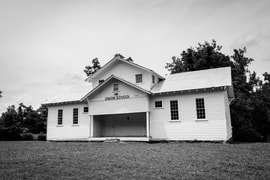Native American RootsJohnson County holds a notable landmark called the Serpent Cave, named on the National Register of Historic Places for its art. Serpent Cave is a cave of red sandstone which walls hold Native American hieroglyphics depicting what seems to be various possible reptiles, hence the name of the cave. While the hieroglyphics have never been translated, it does indicate Johnson County’s long history, beginning with the Native Americans.
|
|
county Name OriginPresent-day Johnson County was originally Osage land, but later became a part of a Cherokee reservation established somewhere between 1818 and 1828. Three decades into the eighteenth century, white settlers had steadily begun arriving in the area. On November 16, 1833 Johnson County was officially established, created from part of Pope County. named after Benjamin Johnson, who was an appointed territorial judge.
|
The Original County Seat
The original county seat for Johnson County was Spadra, located on the Arkansas River. Spadra was a hub of activity because it was the location of an Indian trading facility, a trading post authorized by the government which emphasized relationships between settlers and Native American tribes. While Spadra held a great geographical position regarding both the fertile land surrounding the river and the water transportation that came with being on the river, the county seat was eventually moved to the quickly growing Clarksville in 1836.
county Seat of ClarksvilleClarksville was established as the County Seat in 1836 when ¼ mile square on Spadra Creek was offered free to the Commissioners if it were to be used for that purpose. The previous owner of the land was Josiah Cravens, but once it was designated as the County Seat, it was named after another local land owner and Commissioner involved, Lorenzo N. Clark.
|
Industries that Build the County
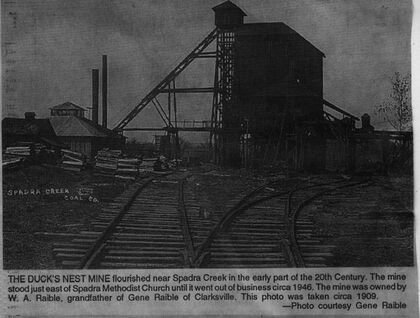
Johnson county has gone through a number of different agricultural, mining, and manufacturing industries that lead to the county’s growth and prosperity. Early settlers began with tobacco production, but this eventually transitioned into cotton. Coal was discovered in the Spadra area by the time the 1840’s rolled around, but the industry would only prosper with the advent of railroads. Coal mining provided a great many jobs, leading people to come from all of the world and immense growth of the county.
The timber industry briefly took hold of the county, with it holding the greatest amount of timber in all of the Arkansas River Valley. In the 1920’s natural gas had been discovered in the county in profitable quantities, which was fortunate because by the 1930’s the timber industry had declined severely. Today, the natural gas industry is still relevant and prosperous in the county.
Fruit crops such as apples, pears, and especially peaches made their way to the forefront when the University of Arkansas in Fayetteville opened a fruit-specialized agricultural branch substation in the county. Poultry also went on the rise in 1952 when a poultry processing plant opened and became one of the largest employers in the county. Finally, Johnson county is a hub of transportation with the Arkansas River, Interstate 40, numerous rail lines, and an airport all making their way through the county. Today, Tyson Foods, a poultry processing operation, has brought economic prosperity to the county in addition to the multitude of diversified agricultural producers (peaches, cattle, vegetables, soybeans, grains). Walmart Distribution Center is another empire that has brought success to the county; the distribution center leading the nation and even bringing home "Grocery Center Distribution of the Year" for the past three years.
The timber industry briefly took hold of the county, with it holding the greatest amount of timber in all of the Arkansas River Valley. In the 1920’s natural gas had been discovered in the county in profitable quantities, which was fortunate because by the 1930’s the timber industry had declined severely. Today, the natural gas industry is still relevant and prosperous in the county.
Fruit crops such as apples, pears, and especially peaches made their way to the forefront when the University of Arkansas in Fayetteville opened a fruit-specialized agricultural branch substation in the county. Poultry also went on the rise in 1952 when a poultry processing plant opened and became one of the largest employers in the county. Finally, Johnson county is a hub of transportation with the Arkansas River, Interstate 40, numerous rail lines, and an airport all making their way through the county. Today, Tyson Foods, a poultry processing operation, has brought economic prosperity to the county in addition to the multitude of diversified agricultural producers (peaches, cattle, vegetables, soybeans, grains). Walmart Distribution Center is another empire that has brought success to the county; the distribution center leading the nation and even bringing home "Grocery Center Distribution of the Year" for the past three years.
Peach CountyThe rise of the peach industry in Johnson County began with two men, James R. Tolbert and Johnson J. Taylor. The two made the decision to purchase and grow Elberta peaches. The venture would prove to be more successful than imagined, spreading to other states and eventually sparking the interest of the Missouri Pacific Railroad Company. This partnership forged between the peach farmers, the county, and the railroad would carry the industry through many financial and environmental setbacks and bring lasting success.
A multitude of peach farms have resided in Johnson County, but the last standing is the Peach Pickin’ Paradise which brings in many visitors from surrounding states. Since the summer of 1938, annual peach festivals have been held in Clarksville. Events range from musical performers to a greased-pig chase to a multitude of beauty pageants. The festival has brought fame to the county, people coming from all over to attend. |
A County of FirstsJohnson County has had many firsts in the state of Arkansas. The first blind school was organized in the county seat of Clarksville, in addition to Johnson County having the first deaf-mute school in 1850. On April 12, 1869, the first organization of the Educational Association took place in Clarksville. On February 23, 1881, it was incorporated.
Later, in 1896, the county was the first to deliver rural mail free. College of the Ozarks, now called the University of the Ozarks, School of Pharmacy was the first in the state in 1946. The University actually had many firsts in the state, including the first Jones Learning Center, which accommodates and assists students with disabilities, and the first female graduate. Clarksville managed to not only grow with the times but sometimes be ahead of its time. The city was the first in the state to operate completely powered by solar energy, as well as the first to have 2 gig high speed fiber. Another notable advance would be that the city is one of two in the state to have its water be cleaned by Ozone gas instead of chemicals. Clarksville holds a rich history of innovation. |
Johnson County Courthouse:
|
MIssouri-Pacific DepotThe Missouri-Pacific Depot in Clarksville was constructed circa 1910 by the Missouri-Pacific Railroad in hopes to expand the railroad system throughout the country. Designed in the popular Mediterranean style of the time, it was a single-story, brick masonry freight and passenger railroad depot. The original ceramic tile roof did not survive all the way to today, however many unique features still stand that have cemented the building’s place in history. The depot’s association with the growth of the railroad and it’s preserved Mediterranean style lead to the Missouri-Pacific Depot in Clarksville being named on the National Register of Historic Places. Today the Missouri-Pacific Depot houses the Clarksville-Johnson County Chamber of Commerce.
|
Bunch-Walton Post 22 American Legion Hut
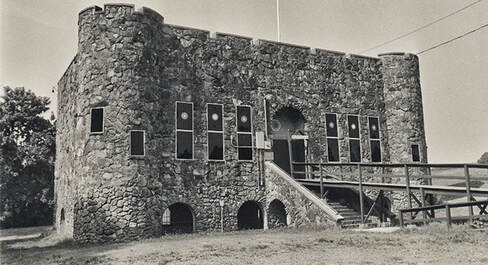 Bunch-Walton Post 22 American Legion
Bunch-Walton Post 22 American Legion
A two-story, native-stone structure sitting on a raised foundation resides in the
county seat of Clarksville. The Normanesque appearance with castellated turrets makes the Bunch-Walton Post 22 American Legion Hut yet another architecturally distinct building that made its way onto the National Register of Historic Places on January 24, 2007.
The style is thought to be reminiscent of the architecture of Europe during
World War I. In February of 1919, the Lee Bunch Post 22 was formed and
named in commemoration of Lee Bunch, the first soldier to die in World War I
that hailed from Johnson County. The group met anywhere possible locally, until
the Civil Works Administration (a federal relief agency during the Great Depression) approved the construction of a community building in Clarksville in 1934
On Memorial Day of that year, the building was dedicated by the Arkansas Department commander of the American Legion, Charles Q. Kelley. Following World War II, the chapter was renamed to commemorate another honorable soul lost to the war. Captain Raymond Charles Walton was the co-pilot of a bomber shot down over Italy in 1943 and the first casualty of WWII from Johnson County. Although faced with many obstacles, from vandalism to tornadoes and flooding, the building has survived, representing the strength and beauty of Johnson County.
county seat of Clarksville. The Normanesque appearance with castellated turrets makes the Bunch-Walton Post 22 American Legion Hut yet another architecturally distinct building that made its way onto the National Register of Historic Places on January 24, 2007.
The style is thought to be reminiscent of the architecture of Europe during
World War I. In February of 1919, the Lee Bunch Post 22 was formed and
named in commemoration of Lee Bunch, the first soldier to die in World War I
that hailed from Johnson County. The group met anywhere possible locally, until
the Civil Works Administration (a federal relief agency during the Great Depression) approved the construction of a community building in Clarksville in 1934
On Memorial Day of that year, the building was dedicated by the Arkansas Department commander of the American Legion, Charles Q. Kelley. Following World War II, the chapter was renamed to commemorate another honorable soul lost to the war. Captain Raymond Charles Walton was the co-pilot of a bomber shot down over Italy in 1943 and the first casualty of WWII from Johnson County. Although faced with many obstacles, from vandalism to tornadoes and flooding, the building has survived, representing the strength and beauty of Johnson County.
Union School House
The Union School is located 11 miles from Hagarville and is yet another Johnson County place located on the National Register of Historic Places. The school house served the Mt. Levi community in the Ozark National Forest, in a county where education in rural areas was valued. The Union School was built in 1929 by Willis Warren and Orville Skaggs (among other carpenters and craftsmen) to replace the original school house built in the same spot that had burned down the previous year. The Union School has an exterior and interior finish of wood with a solid foundation composed of stone. The traditional two story school house also served Mt. Levi by providing as a community center, Masonic Lodge, and a church. The building still stands tall today, preserving history in its walls.
The History of Johnson County's Courthouses 1838-Present
Johnson County's First Courthouse 1838-1873
The First few courts held in this district were at the home of Bettie Alston of Spadra, but later the county site was established at Clarksville and the courthouse erected. The court room was on the lower floor and a portion of the upper level was used for the grand jury. Later two rooms were added and the West wing was used as the office for the clerk. In 1850, there was an order by the county judge that A.M. Ward, the county clerk, was appointed as a commissioner to rent the East wing for $25 per year. In 1855, after the rent expired, the county sheriff was given the privilege of taking charge of the room for his office. Property, real and personal, including enslaved persons were sold from the courthouse steps. This courthouse was destroyed by fire in 1872. Many of the records were salvaged and can be accessed at the Johnson County Historical Society.
Johnson County's Second Courthouse 1874-1935
Contracted work began February 1, 1873 and construction lasted until June 30, 1874. The cornerstone of the courthouse was removed in May 1935 to reveal a small metal box that contained a time capsule. Interesting objects inside were three old coins, three copies of newspapers, two tin type photographs, the court order, names of officials, names of contractors and names of workmen on the building. the coins were a Canadian half penny, a nickel dated 1862, a nickel dated 1869, with a large number "5" on one side and a shield on the other; and a dime on which the date could not be read. Two copies of the Clarksville Enterprise (dated May 31, 1873 and August 30, 1873) and the Little Rock Daily Republican, dated Monday morning September 1, 1873. the time capsule was placed in the current courthouse during construction.
Johnson County's Third Courthouse 1936-Present
The present Johnson County Courthouse was built in 1936. The cost of the building was $75,000, including 4 modern vaults and fireproofing. 30% ($22,500) of the cost was covered by the government grant. The new building is 93 x 70 feet. In 1990, Johnson County Courthouse was listed on the National Register of Historic Places. The current courthouse of Johnson County is one the modern end of style. Although it was built in 1936, it is the typical style of building that still exists in most towns across the nation that succumbs to renovations to keep up with ever changing technologies without having to perpetually build new buildings, which would prove to be quite costly. Offices are on the first floor of this courthouse, with courtrooms on the second along with offices for county and circuit judge.
About Johnson County
Johnson County is in the western section of Arkansas that ranges from 10-30 miles in width and 27 miles in length that equates to 700 square miles. Johnson County includes 5 towns: Clarksville, Lamar, Knoxville, Hartman, and Coal Hill. Johnson County was created and named after the first territorial Honorable Judge Benjamin Johnson on January 23, 1820 by President James Monroe. Johnson County had many first in the state. The first blind school was organized in Clarksville and the first deaf-mute school was here in 1850. The College of the Ozarks School of Pharmacy in 1946 was the first one in the state. Our first Spadra Creek Bridge was built in 1852. The first free delivery of rural mail in Arkansas began in Johnson County 1896. The first Educational Association organized in the state was organized in Clarksville, April 12, 1869, and was incorporated on February 23, 1881.
The Johnson County Historical Society objectives are to preserve the heritage of Johnson County and the history of the families who were instrumental in it’s shaping. Explore the Johnson County history and do research through the many books, original records and photographs available in the museum exhibit. This is a great place to go for genealogy research and projects. We invite you to share your Johnson County stories with us and ask any questions you have. We’ll try our best to help.
Did you know the Heritage Center Museum is financed only by donations and memorials? The museum cannot remain open without volunteers and financial support. Your help is vital and greatly appreciated. Johnson County Historical Society is a 501 © 3 non-profit and welcomes your tax-deductible donations.
The First few courts held in this district were at the home of Bettie Alston of Spadra, but later the county site was established at Clarksville and the courthouse erected. The court room was on the lower floor and a portion of the upper level was used for the grand jury. Later two rooms were added and the West wing was used as the office for the clerk. In 1850, there was an order by the county judge that A.M. Ward, the county clerk, was appointed as a commissioner to rent the East wing for $25 per year. In 1855, after the rent expired, the county sheriff was given the privilege of taking charge of the room for his office. Property, real and personal, including enslaved persons were sold from the courthouse steps. This courthouse was destroyed by fire in 1872. Many of the records were salvaged and can be accessed at the Johnson County Historical Society.
Johnson County's Second Courthouse 1874-1935
Contracted work began February 1, 1873 and construction lasted until June 30, 1874. The cornerstone of the courthouse was removed in May 1935 to reveal a small metal box that contained a time capsule. Interesting objects inside were three old coins, three copies of newspapers, two tin type photographs, the court order, names of officials, names of contractors and names of workmen on the building. the coins were a Canadian half penny, a nickel dated 1862, a nickel dated 1869, with a large number "5" on one side and a shield on the other; and a dime on which the date could not be read. Two copies of the Clarksville Enterprise (dated May 31, 1873 and August 30, 1873) and the Little Rock Daily Republican, dated Monday morning September 1, 1873. the time capsule was placed in the current courthouse during construction.
Johnson County's Third Courthouse 1936-Present
The present Johnson County Courthouse was built in 1936. The cost of the building was $75,000, including 4 modern vaults and fireproofing. 30% ($22,500) of the cost was covered by the government grant. The new building is 93 x 70 feet. In 1990, Johnson County Courthouse was listed on the National Register of Historic Places. The current courthouse of Johnson County is one the modern end of style. Although it was built in 1936, it is the typical style of building that still exists in most towns across the nation that succumbs to renovations to keep up with ever changing technologies without having to perpetually build new buildings, which would prove to be quite costly. Offices are on the first floor of this courthouse, with courtrooms on the second along with offices for county and circuit judge.
About Johnson County
Johnson County is in the western section of Arkansas that ranges from 10-30 miles in width and 27 miles in length that equates to 700 square miles. Johnson County includes 5 towns: Clarksville, Lamar, Knoxville, Hartman, and Coal Hill. Johnson County was created and named after the first territorial Honorable Judge Benjamin Johnson on January 23, 1820 by President James Monroe. Johnson County had many first in the state. The first blind school was organized in Clarksville and the first deaf-mute school was here in 1850. The College of the Ozarks School of Pharmacy in 1946 was the first one in the state. Our first Spadra Creek Bridge was built in 1852. The first free delivery of rural mail in Arkansas began in Johnson County 1896. The first Educational Association organized in the state was organized in Clarksville, April 12, 1869, and was incorporated on February 23, 1881.
The Johnson County Historical Society objectives are to preserve the heritage of Johnson County and the history of the families who were instrumental in it’s shaping. Explore the Johnson County history and do research through the many books, original records and photographs available in the museum exhibit. This is a great place to go for genealogy research and projects. We invite you to share your Johnson County stories with us and ask any questions you have. We’ll try our best to help.
Did you know the Heritage Center Museum is financed only by donations and memorials? The museum cannot remain open without volunteers and financial support. Your help is vital and greatly appreciated. Johnson County Historical Society is a 501 © 3 non-profit and welcomes your tax-deductible donations.
Photo credit for above photos: Todd Sadowski Photography
For more information please see:
“Asset Detail.” National Parks Service, U.S. Department of the Interior, npgallery.nps.gov/NRHP/AssetDetail/65f06e74-40d6-43ad-8171-fbd3795421cf.
Christ, Mark K. “Bunch-Walton Post 22 American Legion Hut.” Encyclopedia of Arkansas, 9 Nov. 2020, encyclopediaofarkansas.net/entries/bunch-walton-post-22-american-legion-hut-8709/.
Craig, Jared. “Johnson County Courthouse.” Encyclopedia of Arkansas, 12 Nov. 2020, encyclopediaofarkansas.net/entries/johnson-county-courthouse-9159.
“Johnson: Association of Arkansas Counties.” Johnson | Association of Arkansas Counties, arcounties.org/counties/johnson/.
“Johnson County.” Encyclopedia of Arkansas, 29 Jan. 2020, encyclopediaofarkansas.net/entries/johnson-county-780/.
Johnson County Historical Society. “Johnson County Courthouses.” Clarksville, clarksvillejocochamber.com/johnson-county-courthouses.html.
Johnson, Koenig Jennifer. “Johnson County Peach Festival.” Encyclopedia of Arkansas, 19 Mar. 2019, encyclopediaofarkansas.net/entries/johnson-county-peach-festival-4407/.
Mickel, Lillian. “County History.” Johnson County, Arkansas, johnsoncounty.arkansas.gov/county-history.
National Archives. National Archives and Records Administration, National Archives and Records Administration, catalog.archives.gov/id/26139851.
¨National Register of Historic Places Registration Form.” United States Department of the Interior, National Park Service, NPS Form 10-900, Oct 1990, arkansasheritage.com/docs/default-source/national-registry/JO0214-pdf.
“Organization and Early History in Johnson County, Arkansas.” Genealogy Trails History Group - Finding Ancestors Wherever Their Trails Lead, genealogytrails.com/ark/john/cohist.html.
“Spadra (Johnson County).” Encyclopedia of Arkansas, 21 Dec. 2020, encyclopediaofarkansas.net/entries/spadra-johnson-county-3510/.
Christ, Mark K. “Bunch-Walton Post 22 American Legion Hut.” Encyclopedia of Arkansas, 9 Nov. 2020, encyclopediaofarkansas.net/entries/bunch-walton-post-22-american-legion-hut-8709/.
Craig, Jared. “Johnson County Courthouse.” Encyclopedia of Arkansas, 12 Nov. 2020, encyclopediaofarkansas.net/entries/johnson-county-courthouse-9159.
“Johnson: Association of Arkansas Counties.” Johnson | Association of Arkansas Counties, arcounties.org/counties/johnson/.
“Johnson County.” Encyclopedia of Arkansas, 29 Jan. 2020, encyclopediaofarkansas.net/entries/johnson-county-780/.
Johnson County Historical Society. “Johnson County Courthouses.” Clarksville, clarksvillejocochamber.com/johnson-county-courthouses.html.
Johnson, Koenig Jennifer. “Johnson County Peach Festival.” Encyclopedia of Arkansas, 19 Mar. 2019, encyclopediaofarkansas.net/entries/johnson-county-peach-festival-4407/.
Mickel, Lillian. “County History.” Johnson County, Arkansas, johnsoncounty.arkansas.gov/county-history.
National Archives. National Archives and Records Administration, National Archives and Records Administration, catalog.archives.gov/id/26139851.
¨National Register of Historic Places Registration Form.” United States Department of the Interior, National Park Service, NPS Form 10-900, Oct 1990, arkansasheritage.com/docs/default-source/national-registry/JO0214-pdf.
“Organization and Early History in Johnson County, Arkansas.” Genealogy Trails History Group - Finding Ancestors Wherever Their Trails Lead, genealogytrails.com/ark/john/cohist.html.
“Spadra (Johnson County).” Encyclopedia of Arkansas, 21 Dec. 2020, encyclopediaofarkansas.net/entries/spadra-johnson-county-3510/.



